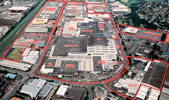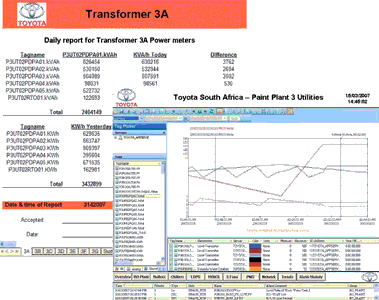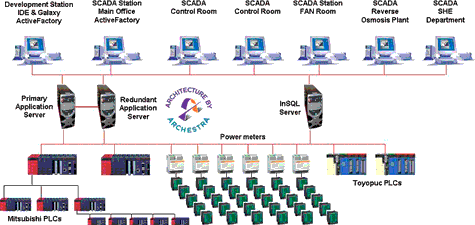
For Toyota SA Motors to meet its goal of 220 000 units per annum by 2009, it needed to extend the capacity of its two existing paint plants at the company’s Durban factory. It was decided to add a third paint plant using the basic design in line with five other paint plant facilities currently being constructed across the world and to automate this plant with the help of Wonderware industrial software solutions.
While most items for the new paint plant could be imported from Japan, this would not cover utilities functions, which were to be done locally. These involved all power, gas, air, and water utilisation and control together with the air purification and humidity control. The project was divided into three plant areas:
* The power control and monitoring including the standby generator and UPS control.
* The HVAC (heating, ventilation and airconditioning) control which included the boilers, chillers and fresh air ventilation system.
* The reverse osmosis (RO) plant was added to the project at a late stage, as this was originally a standalone system that was completed by another supplier.
The easy integration of these three areas highlighted the flexibility and expandability of Wonderware's ArchestrA. So much so that the next two plant areas are currently under discussion as to when they can be added to the system (plant alarms to security and body shop 2).

Project goals
Toyota's project goals for the control and reporting system included:
* Utilities cost breakdown - to ensure accurate utility cost breakdowns per plant area and manufactured vehicle.
* Centralised engineering - to achieve a central development environment with a common database structure.
* Ensure a stable and sustainable platform - to provide a stable base, which is flexible enough to accommodate future expansion.
* Deliver process optimisation/consistency - to provide rigorous production and performance measurement and management.
* Production flexibility - to be easily adaptable to cater for production variations.
* Improve reporting - to ensure that timely and meaningful production information would be available at all times.
* Knowledge transfer and skills development - to be in a position to 'own' and control the system without outside help.
* Simple to maintain - to maintain the system in-house.
Solution selection
Wonderware was selected for various reasons, one of which was their comprehensive product offering capable of seamless integration with future applications. But one of the main reasons for the choice was that Toyota is an existing Wonderware.
"ArchestrA's flexibility and scalability was a good fit for Toyotas business growth strategies," says Jaco Delport of Toyota SA. "As our needs grow in the future, we will be able to simply add application servers and continue to work in a single 'galaxy' with virtually unlimited tags. With multiple manufacturing plant areas on site, ArchestrA provides a central point of configuration, which simplifies system maintenance."
Toyota SA chose ArchestrA-certified system integrator Convenient Software Solutions (CSS) for the project implementation. "We have developed a set of software standards and this was made available to Toyota SA, saving them time and money on engineering costs," says Pieter Venter of CSS. "Also important was Wonderware's partnership with connectivity and network solution suppliers like Software Toolbox who can connect to almost any device. Not many other suppliers can readily connect to Toyopuc PLCs, for example."

Implementation
During the conceptual design phase, all the software structures for PLCs, ArchestrA and the InTouch View stations were defined. A tag name convention in line with the ISA standards was implemented to be more descriptive of plant areas and devices. This was expanded to include the addressing structure at the PLC and ArchestrA levels and defining how they interact via Smart Symbols. During this phase the plant operators and production personnel were consulted to ensure an operator-friendly graphical interface and navigation screens.
Since most of the data required in the supervisory system came from different device types, it was necessary to define the communication methods and rules as the system spanned across various networks and protocols.
During the detailed design phase, all the ArchestrA objects and smart symbols were created and alarm management philosophies were defined while security levels were set up for various user groups. A complete thin slice of the system was set up and tested before initiating the rollout.
"Once we completed the design phase," says Venter, "all plant devices like power meters were created using instances of the objects and smart symbols as designed. This is where ArchestrA really comes into its own as it greatly reduces engineering time. As we were working in a realtime environment while the plant was still being built, we could deploy objects in use as the installation people completed sections of the plant, allowing them to commission while the installation was in progress."
Final acceptance testing was completed during the thin slice testing in the design phase and was redone at various stages of the rollout phase. Final commissioning was completed on a progressive basis as this was dictated by the availability of the plant.
To enable reporting, all critical plant data was logged to the IndustrialSQL Server realtime historian. The reports were generated using ActiveFactory and Microsoft Excel and then shared via ActiveFactory WEB to other ActiveFactory users on the network. The reports, which focus on power, air, gas, water and effluent, include shift information as well as daily, weekly and monthly summaries.
"Since commissioning, these reports and the management decisions based on their accuracy has ensured an important reduction in plant operational costs and a project ROI time significantly shorter than originally anticipated," adds Delport.
Benefits
* Improved utilities management - Toyota SA can now monitor all areas of the plant and their respective utility utilisation and associated costs.
* Centralised control - all utilities such as water, gas, air and power can now be managed from a central location but viewed across the plant.
* Operational cost per unit - cost can now be allocated to each manufactured vehicle.
* Safety, health and environmental - tracking the effluent produced has resulted in improved control over its production. Toyota SA is now able to exceed required environmental standards.
* Centralised development environment - has led to a skills transfer between the CSS engineers and Toyota SA's plant technicians.
* Pool of skills and resources - has resulted in a pool of resources capable of maintaining and enhancing the system without outside help.
* Improved reporting - has enabled the control room operators to be more proactive in controlling the critical plant parameters and employees to make sound business decisions based on actual facts rather than guesswork.

Summary and conclusion
The scheduled start-up date for production was November 2006. However, Toyota Japan decided to surprise everybody by launching the new Hilux IMV earlier than planned. The market demand was such that it forced the launch date to be brought forward by two months, which required the completion of priority areas earlier than intended in order to support the start-up process. All other areas were completed during the following two months and the project was completed within the original time period.
For more information contact Justin Tweedie, Wonderware Southern Africa, +27 (0)861 WONDER, [email protected], www.wonderware.co.za

© Technews Publishing (Pty) Ltd | All Rights Reserved